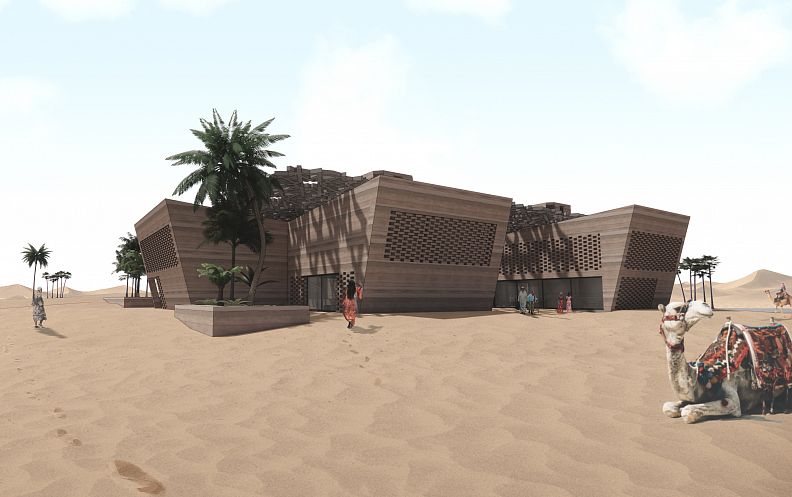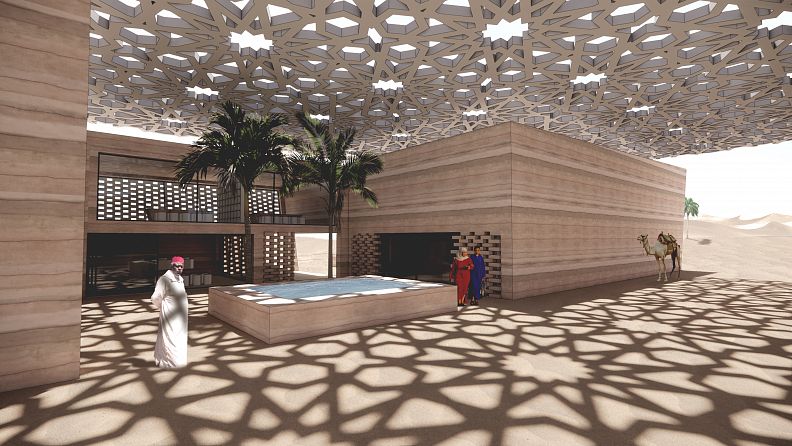Cultural Oasis Center, Morocco

Project idea
The design of the cultural center at the Lalla Takerkoust Dam, forty kilometers from the Moroccan city of Marrakech, was created as part of the Culture Oasis competition. The design concept is based on adaptability to weather conditions and is also based on the efficient use of environmental energy to improve the indoor climate in buildings. The design is based on the principle of desert tents, which people have built in a closed shape to create an internal leeward and more pleasant environment, a cactus that first had to adapt to these conditions to survive in extreme conditions and a ventilation tower typical of architecture in Morocco, but also Africa, and helps to create a better living environment for people in and around buildings. The typical shape of the floor plan of the tent in the desert is a rectangle, the closed arrangement creates a traditional common space and is energetically advantageous, and the shape and angle of the ventilation towers is adapted to the wind direction in the solved area. The mass of the design is the result of analyzes of weather and weather conditions and has been fully adapted to them. The location of the building is adapted to naturally created walking routes, which are also connected to roads.
Návrh kultúrneho centra pri priehrade Lalla Takerkoust, štyridsať kilometrov od marockého mesta Marakéš, vznikol v rámci súťaže Culture Oasis. Konceptom návrhu sa odvíja od prispôsobivosti poveternostným podmienkam a je taktiež založený na efektívnom využívaní energie prostredia na zlepšenie vnútornej klímy v budovách. Návrh sa odvíja z princípu stanov v púšti, ktoré si ľudia stavali do uzavretého tvaru, aby si vytvorili vnútorné závetrie a príjemnejšie prostredie, kaktusu, ktorý sa pre prežitie v extrémnych podmienkach musel týmto podmienkam najskôr prispôsobiť a vetracej veže, ktorá je typická pre architektúru v Maroku, ale aj Afrike a pomáha vytvárať ľuďom v budovách a okolí lepšie prostredie pre život. Typický tvar pôdorysu stanu v púšti je obdĺžnik, uzatvorené usporiadanie vytvára tradičný spoločný priestor a je energeticky výhodný a tvar a uhol umiestnenia vetracích veží je prispôsobený smeru vetra v riešenej oblasti. Hmota návrhu je výsledkom analýz počasia a poveternostných podmienok a naplno sa im prispôsobila. Umiestnenie stavby je prispôsobené prirodzene vytvoreným peším trasám, ktoré sú tiež napojené na cestné komunikácie.
Project description
Dispositionally, the mass is divided into smaller units. In the underground spaces there is a technological background, warehouses and toilets. The first floor consists of spaces such as a theater, library, spaces for typical Moroccan crafts - pottery, cafeteria, music room and exhibition space. The second floor unfolds from the one below it.
Dispozične je hmota delená do menších celkov. V podzemných priestoroch sa nachádza technologické zázemie, sklady a toalety. Prvé nadzemné podlažie tvoria priestory ako divadlo, knižnica, priestory pre typické marocké remeslo – hrnčiarstvo, kaviareň, hudobná miestnosť a výstavný priestor. Druhé nadzemné podlažie sa odvíja od toho pod ním.
Technical information
The building is designed from ecological, affordable materials and traditional construction techniques are also used. It is a combination of walls made of hammered clay with reinforced concrete ceiling panels.
Stavba je navrhnutá z ekologických, dostupných materiálov a využité sú taktiež tradičné stavebné techniky. Ide o kombináciu stien z ubíjanej hliny so železobetónovými stropnými panelmi.



























